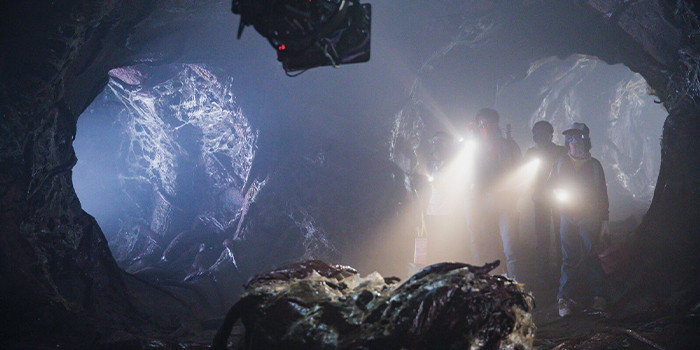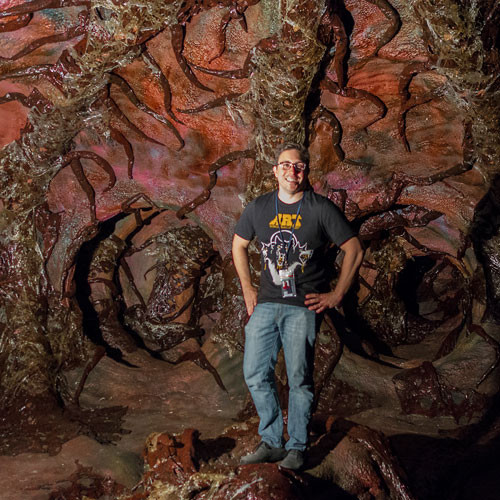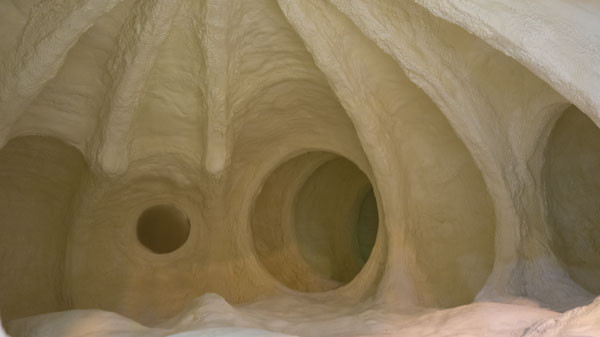Stranger Spray Foam Applications


Spray Foam Magazine – Fall Issue 2019 – Spray foam insulation has many consumer benefits and applications, but this particular use is beyond a little “strange.” The Spray Foam Magazine team had the privilege of interviewing Rob Nagy, a set designer from Netflix’s hit TV series, Stranger Things, to quiz him on set design and the use of spray foam to create some incredible scenes, which impress visually and are also downright scary.
Winning numerous awards and receiving 31 Emmy award nominations, the science fiction/horror series Stranger Things, directed by the Duffer brothers, has to be one of the biggest TV sensations of recent times. Set in the fictional town of Hawkins, Indiana during the 1980s, the series transports viewers back to a time where kids would play outside, go on adventures, and get into all sorts of trouble. The feel of this period-correct, eighties-homage, and well-written TV show is a combination of classic movies such as E.T., The Goonies, and Aliens.
The first season is based around the vanishing of a young boy due to a seemingly supernatural occurrence in the town and the arrival of a girl with extraordinary powers. The second season focuses on the characters trying to return to a normal life after the events of the first season, and the third season sees a return of the “unusual.”
Chatting with Rob Nagy, it soon becomes apparent this is a guy who is articulate, creative, and has an immense passion for all things set design. Born in Toronto, Canada, Rob moved to the U.S. when he was in high school. For his undergrad, he went to the University of Chicago, where he studied liberal arts with a biology major. He then took a year off and decided to focus on architecture, achieving a master’s degree in architecture from Georgia Tech.
Working as an architect in both Georgia and New York until 2008, Rob recalls, “The crash happened around 2013 and I decided to move back to Atlanta, where my wife and I both have family.”
When he moved back to Atlanta, he took a job as an art production assistant on the feature film, Selma. He states, “It’s a little bit of luck and who you know. After Selma I worked on another show and I was good friends with the location coordinator. After that show ended he reached out to me and said, ‘We are doing this Netflix show, are you interested?’ I said, ‘Sure pass on my information.’ Next thing you know I get an email from the art director saying ‘We would like you on board.’”

Rob Nagy
Rob and another set designer, Justin Trudeau, who also happens to have a degree in architecture, worked with a full construction crew. Rob clarifies, “There are roughly 100 people working on these sets. There is a construction coordinator, and then you have a different foreman for each set. The mill is where everything is built and then either brought to location or brought to stage.”
The crew is divided into Construction and Scenic. Once Construction gets everything up and running, Scenic will come and take everything over. Along with Rob and Justin, there are three other people to make these concepts become a reality—production designer, Chris Trujillo who designs the whole show, Jessica Royal, the set decorator (for season one) who is in charge of furniture and fixtures, and Sean Brennan, the art director who is in charge of the art department. After meeting with this team and collaborating on ideas, Rob would go off and start to build models.
Rob was a kid growing up in the eighties, and like many of the show’s fans, memories are triggered from the music used in the show, to the décor and toys. Rob laughs, “There was an Atari that appeared on the show and I was like, oh my, I had that when I was a kid.”
Reading through the scripts, Rob and the crew knew that this was a good show, but he states, “You never really know. There’s always a question mark. There wasn’t a massive marketing push for it so we really didn’t know.”
Rob and the art department crew works heavily with the location department. They not only spend time in the office, but they will also have to go and survey the space or location to design any changes accordingly. There are also sets that are built directly on to a stage.
A lot of the look and feel of the set comes from the art department, but with Rob’s main set on the series (The Wheeler’s house), they looked to movies such as E.T. For the kitchen itself, Rob and the team went through an eighties kitchen design catalogue.
Mike Wheeler (not to be confused with the character played by Finn Wolfhard) is the construction coordinator on the show, and he is the person who takes the models to the construction phase. He is also in charge of hiring the right people to get the job done. Mike explains how spray foam was used throughout the Stranger Things sets, most prominently in the second season, for the tunnels, or “The Hub” as they were referred to by the characters in the series. The Hub is a series of underground tunnels connected to each other and was described by the character Chief Hopper as being like a ‘graveyard.’ The company hired to spray the foam onto the tunnel structure was GCS Spray Foam Insulation, based out of Atlanta, Georgia.”

To create the tunneling system portrayed in the show, the set designers used wood frames and then covered them with closed-cell foam.
Photo provided by Rob NagyIf you are familiar with the show, the tunnels branched off from the gate from The Upside Down leading underground to the fictional town of Hawkins. Nagy goes on to describe the tunnels,
“I remember the production designer showing me what looked like ribbing. We were trying to come up with a tunnel-like feel, which had some ribbing in there too. We always referred to it as a tunneling system, which first appears after episode 2.04 and covers about five different sets.” Wheeler continues to elaborate on the process to build the tunnels, “We used muzzle cloth and chicken wire frames, and then we made wooden ribs to hold the structure until it was complete. The tunnels were made out of closed-cell polyurethane foam.”
Marc Newman, owner and operator of GCS Spray Foam Insulation describes the experience of working on the set. “We had one supervisor and two lead sprayers spraying three different film sets, which took approximately three to four days of spraying per set. The foam we used was Premium Spray Products, which is based nearby in Marietta, Georgia.”
The GCS team sprayed 24 sets of two-pound Foamsulate closed-cell foam. They took safety seriously wearing Tyvek suits, full-face respirators with particulate and vapor cartridge filters, gloves, standard first aid kit, and an eye wash station.
Mike Wheeler highlights, “The spray foam contractors came in for two to three days, went for a couple of weeks and then came back for two or three days. Wheeler states, “There were so many variations of those tunnels, we had a couple hundred feet of them.”
Foam was not only used on this particular part of the set but for many features like sculptures and different carvings required for backdrop scenes. In the first season, spray foam was used for a wall where a demogorgon (a monster which was made from latex) breaks through from another dimension to the Hawkins National Laboratory. Many of the stones and rock faces in season two were made out of spray foam and then carved to match where the location was supposed to be, the fictional town in Indiana.
In the show there are a number of portals used by demogorgons from the Upside Down, which enable them to travel back and forth from their dimension to Hawkins, Indiana. One such portal was a massive tree, which happens to be made out of spray foam. Marc Newman from GCS said, “Spray Foam is a great product for any type of prop or filming set...you can paint it and carve it into just about anything.”
The third season of Stranger Things was released last October on Netflix and season four is currently being filmed. Rumor has it that spray foam is scheduled to be making another star appearance. So if you haven’t already, get to binging the series, and see if your trained eye can spot its creations.
Disqus website name not provided.




































